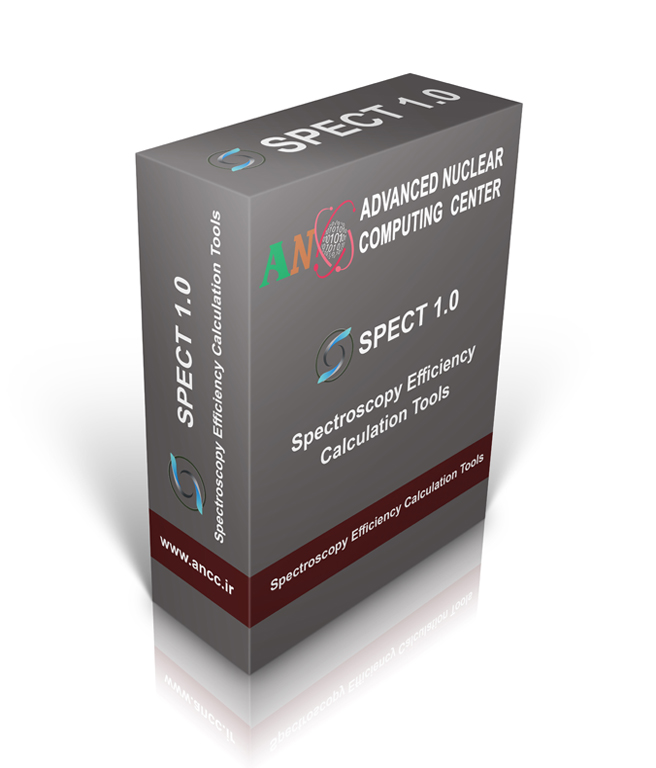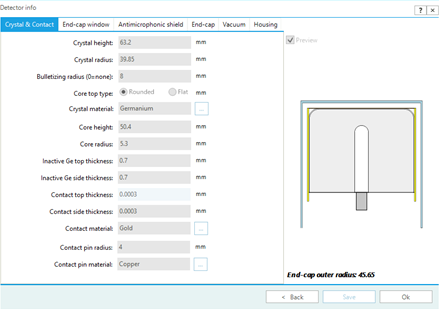
SPECT1.0
A simulation software for the HPGe detector counting calibration with true and random coincidence correction
INTRODUCTION
High Pure Germanium (HPGe) detectors are widely used for low level gamma spectroscopy, radioisotope identification, and material analyses. However, a quantitative measurement requires a calibration relationship between the spectrum peak area and the corresponding isotope density. The calibration data may be acquired by both experimental and simulation strategies. The most promising simulation method is the Monte Carlo transport of gamma particles in the detection setup. This approach provides the information of scattering, true and random coincidence which are main advantages over other simulation methods.
SPECT is a simulation software for HPGe detector calibration with the ability of true and random coincidence correction. The structure of SPECT includes a Monte-Carlo gamma transport kernel, a library of radioisotopes gamma emission, and a user friendly GUI for the ease of application. The design of SPECT is under the inspiration of well-known simulating software of the same field such as ANGLE (from ORTEC Company) and GESPECOR (by the physics department of Bucharest University). However, SPECT provides tools for flexible problem definition, various simulation modes, random coincidence correction, etc.
SPECT gets problem input data in four main categories of Detector, Container, Particle source, and additional geometries (Background shield).


In SPECT a detector can be defined with detailed parameters of crystal dimensions, dead layerand end-cap thicknesses, housing features, etc, which approximate the simulation as close as possible to its real counterpart.

METHODOLOGY
SPECT takes Monte Carlo approach for calculation of gamma counting calibration data in an arbitrary spectroscopy setup. Three modes of operation are considered in the software for the simulation including pulse height spectrum, full peak efficiency, and total detection efficiency. There is an additional option for the automatic reference to unknown setup counting efficiency transfer as calculated in ETNA and ANGLE.
The process of gamma transport considers photo-electric, Compton scattering, and pair production in all parts of the setup including detector, shield, container and source medium. The secondary particles such as scattered gamma, and positron annihilation gammas are also tracked through the matter.
In the pulse height calculation mode, the whole history of the initial and secondary particles is calculated to give the detailed deposited energy spectrum in the sensitive part of the detector. The realistic energy spectrum can be calculated by providing detector resolution data.
In order to reduce the computation time, the full peak efficiency calculation mode is designed to cut the particle history under the situations that do not lead to full energy absorption of the main photon in the sensitive volume of the detector. Total detection efficiency mode counts all the events leading to energy deposition in the sensitive volume. The results from these modes can be used for efficiency transfer calculation between reference and unknown setups.
SPECT also provides options to consider true and random coincidence in all operating modes. The true coincidence is the phenomenon of simultaneous absorption of two or more gamma particle emitting from the same isotope radioactive decay. In fact, true coincidence rate is independent of the detector dead time and source activity. The embedded library in SPECT includes all the necessary data for true coincidence calculation. On the contrary, the random coincidence refers to the situation where two or more photons originating from different radioactive decays are absorbed in a pulse time window of the detection system. This kind of coincidence increases exponentially with the detector dead time and source activity. Therefore, SPECT calculates random coincidence rate based on the input data about detector signal shaping time and activity of the radiation source.
FEATURES
SPECT benefits the following outstanding features that makes it a powerful and accurate tool in the gamma spectroscopy laboratories:
- Calculation of detailed pulse height spectrum with and without energy broadening effect. Both true and random coincidence can be activated in this operation mode. Therefore, all features including annihilation peaks, full peaks, Compton edge, Compton continuum, double peak events are seen in the result spectrum.
- Efficient calculation of full peak counting efficiency with considering scattering, and coincidence. This mode is very useful for comparison of simulation data with experimental results and provides absolute calibration curve. The inaccuracy of the input data can lead to large deviation in the full peak results especially in the low energy range.
- Total counting efficiency calculation. These data are useful to provide relative calibration curves where exact data of the setup is not provided.
- Calculation of Transfer function of the gamma counting efficiency. This option provides a simple relationship between a reference and a new setup. Behind the scene, all necessary calculations including full peak efficiency calculation for the setups, transfer, and error propagation are done automatically.
APPLICATIONS
The main application of SPECT is to generate calibration curve of gamma counting efficiency for the HPGe spectroscopy. The simulation approach is highly useful where standard calibration source is not available for analyzing unknown samples. In such a condition, full energy peak efficiency calculation can provide a good estimation of the calibration data for the unknown samples. Moreover, the combination of experimental result from standard sources and calculated transfer function gives a high quality calibration curve for new source matrix.
On the other hand, the realistic pulse height spectrum can be used to evaluate spectrum analysis tools such as GammaVision. In fact, more detailed results can be derived to relate isotope intensity to the peak area calculated by spectrum analyzer. Furthermore, the coincidence correction number for spectrum analysis can be calculated by SPECT via comparison simulation results with and without activation of coincidence options.

